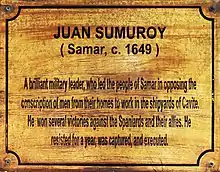Agustín Sumuroy (better known as Juan Sumuroy) was a Filipino hero and Waray leader of the Sumuroy Rebellion, a rebellion of native Filipinos against colonial Spanish forces that occurred in eastern Visayas in 1649-1650. [1]
Agustin Sumuroy is referred to by many as the Waray hero of the Palapag, Northern Samar rebellion during the Spanish time around 1649 to 1650.
There were several personalities in the said uprising: Don Juan Ponce (Ponce being a surname), the leader of the group; Don Pedro Caamug (Caamug being a surname), the second leader; Agustín Sumuroy. The name Juan Ponce Sumuroy is sometimes given to Agustín usually as the result of confusion between Juan Ponce and Agustín Sumuroy.

Sumuroy's Revolt
In 1649, Governor Diego Fajardo ordered men to be sent to the Cavite shipyards. This caused resentment and, eventually, under the leadership of Sumuroy, the people of Palapag, Samar rose in arms. The curate of the town was killed on June 1 and hostilities continued.
The revolt then spread to Masbate, Cebu, Camiguin, and Albay; and Sumuroy won several victories over combined Filipino and Spanish forces. There was a story that when a Spanish commander offered a large sum of money to the rebels for Sumuroy's head, they only returned with a pig's instead.
The revolt ended on July 1650 when government forces successfully staged an assault on the rebels' fort. In the ensuing battle, Sumuroy's mother perished and, after a while, the rebels themselves individually surrendered. The rebels then killed Sumuroy and brought his head to the governor-general.[2]
Legacy
Sumuroy is commemorated in the scientific name of species of gecko, Cyrtodactylus sumuroi, which is endemic to Samar.[3]
References
- ↑ "Commentary: Remembering the seldom-remembered heroes". Philippines Information Agency. 28 August 2007.
- ↑ Halili, M.C. (2010). Philippine History. Rex Book Store, Inc.
- ↑ Species Cyrtodactylus sumuroi at The Reptile Database www.reptile-database.org.